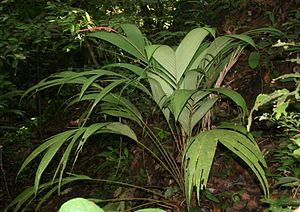Geonomateae
| Geonomateae | ||||||||||||
|---|---|---|---|---|---|---|---|---|---|---|---|---|

|
||||||||||||
| Systematics | ||||||||||||
|
||||||||||||
| Scientific name | ||||||||||||
| Geonomateae | ||||||||||||
| Luerss. |
The Geonomateae are a tribe of the palm family (Arecaceae). Some of their representatives are among the smallest known palm trees.
features
The representatives of the Geonomateae are very small to large, trunkless or upright, unreinforced palms with pinnate or pinnate ribbed leaves. A crown shaft is missing. The inflorescences are spikes or branched up to three times. There is usually one bract on the peduncle , rarely two or more, very rarely it is missing. The flowers are always in triads and sunk into pits in the axis. The petals of the male flowers are fused together to form a soft tube. The gynoeceum is three- or one-sided, the stylus is usually slender and elongated. The fruit is solitary, the scar remains are basal. The exocarp is smooth or slightly pitted but not warty. The endosperm is homogeneous.
distribution
The species of the tribes are restricted to the humid tropics of the New World. Their occurrences range from southern Mexico and the Caribbean islands to the Amazon basin.
Systematics
The Geonomateae as defined by Dransfield et al. (2008) are identified as natural relatives ( Monophylum ) in most studies . They are part of the "core arecoids", but their exact systematic position within the Arecoideae is unclear.
The following genera are included in the tribe:
supporting documents
- John Dransfield, Natalie W. Uhl, Conny B. Asmussen, William J. Baker, Madeline M. Harley, Carl E. Lewis: Genera Palmarum. The Evolution and Classification of Palms . Second edition, Royal Botanic Gardens, Kew, 2008, ISBN 978-1-84246-182-2 , p. 469.